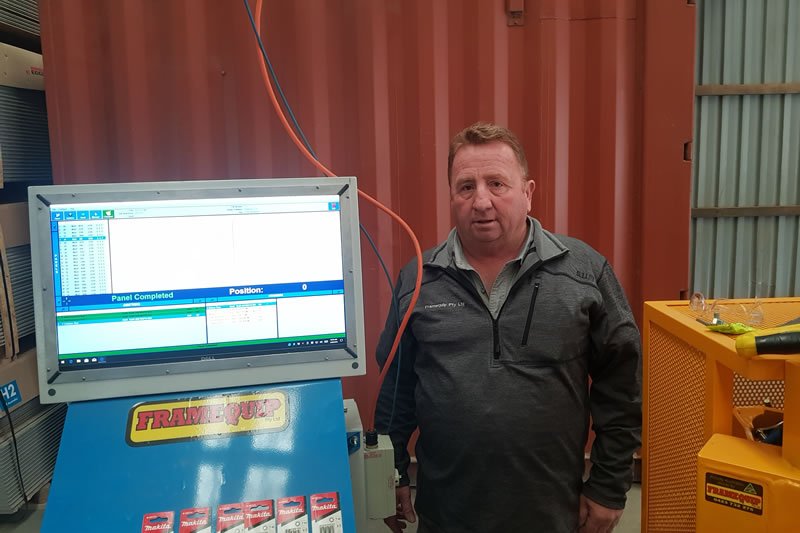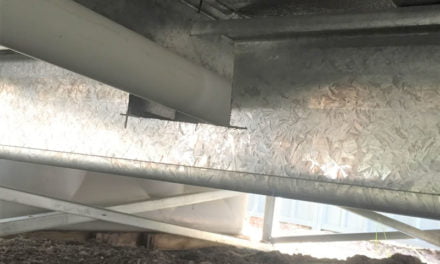By turning to custom-made machinery, fabricators are able to expand their business.
Spend enough time around fabricators and the discussion will turn to changes in the industry. Light timber is still going strong in residential building and low-rise commercial, but engineered timbers are increasingly being used for mid-rise and larger constructions. There’s a growing market for cassettes and panels, for modular product and for specialised work.
For some fabricators, traditional frame and truss is where they want to stay, but for others, growth into new sectors is seen as a competitive edge. Being able to increase the range of what can be fabricated is one way to make sure you can’t be left behind by the market. These are the customers who have helped Rob Armour build his frame and truss machinery company, Framequip.
“I started out in the industry working for Stanley Bostitch in early 1985,” says Armour. “I used to build roof truss machinery, jigs and wall frame machinery. When Stanley Bostitch got out of the machinery business around 2006, I decided that I wanted to continue building machinery, so I started Framequip.”
It was a scaled-back business compared to his career with the renowned multinational: a box of tools, an old ute, a good head for engineering and a good reputation in the industry was the sum total of his starting assets, but it was enough.
“The first machine I built myself was a manual frame line that I built for Riverstone Timber,” says Armour. “My first automated line was for Bunnings in Bundaberg. That was a big order. Those jobs got me going.”
Custom creations
The point of difference for Armour was his ability to customise. While the main part of his business began as framing lines, the smaller-scale nature of his company compared to the big frame and truss machinery firms meant that he was able to create machines that were specific to customers’ needs.
“It evolved,” says Armour. “Each job led from one thing to another. People would ring up and say ‘Rob, we like what you’ve got there, but can you make it this way? Or make it do that thing?’ We’d go away and think about it and come up with solutions. So we were able to come back and say ‘Sure, we’ll give it a crack for you!’”
The standard range now includes nog nailers, auto nailers, waste conveyors, frame lines and more, all of which can be modified to suit the end user’s need. This level of customisation has been at the heart of Armour’s success. “We deal with hundreds of customers a year,” he says. “I get calls from all over the country – all over the world these days – I do work in New Guinea, New Zealand, the US. The thing I enjoy is the interesting range of calls I’ll take in a week.”
But it’s also at the heart of his clients’ success. Smaller fabricators can feel themselves locked out of parts of an industry that is changing rapidly around them. The options are to either stick to what they’ve always done and let go of bidding on a whole range of projects, or to look to ways they can make affordable changes and tool up to do multiple new jobs without requiring multiple new machines.
Larger fabricators may need a machine that is the operational equivalent of ‘last-mile’ transport, filling the gaps that exist in the capacities of their main plant. Or they may choose to invest in a suite of custom machinery for their specific goals.
Armour says that many of his clients come up with ingenious solutions for how they want to grow their business, and his team’s job is then to find ways to make them work. Other times companies come to him with the end result they want, and it’s up to Framequip to find a practical, affordable way of solving the production challenges involved.
He says, “We recently had a company come to us with some special requests for a job. They’ve asked for a riser conveyor system so they can deliver fully assembled window and door components right to the operator’s position. So, we’ve developed a set of inline skates on pneumatic cylinders to carry that out, with a set of chain-driven powered conveyors to drive it up to the delivery point. We’re really proud of that one.”
Commercial realities
In a little over a decade, Armour has seen his business move from mostly manual framing lines to heavy automation. “It’s the direction of the industry,” he says. “The most automated builds are 90 per cent automated, and 90 per cent of my sales now is through automation.”
Reasons for the shift fall into two main categories: accuracy gained is a strong factor, but for smaller companies, the ability to operate with fewer staff also helps considerably. “You can usually do away with one to two men on a fully automated line,” says Armour. “In a year, the machine will pay for itself.”
With labour costs comprising a large component of recurring costs for many frame and truss companies, the politically unpalatable truth is that automation is one quick way of managing the budget. But on the upside, it also frees up staff to do more specialised work, and it can be the driving factor behind a growth in capacity that will lead to future staff growth.
Framequip knows exactly what it’s like to get a lot of work out of a small team: the company has a staff of four. “There’s me and two other fulltime electricians,” says Armour. “One of them writes my PC software and the other one writes my PLC software and they both do a great job. I use those guys as a backstop day in and day out. I also have a fulltime engineer who helps out with a lot of project management, and that’s about the whole team.”
Being able to get the most done with what you have is part of the company ethos, and it spills over into their approach to engineering. Armour knows the frustration of time lost to repairs, and also the rigorous use framing machinery tends to see.
He says, “We build our machines to a point where the engineering is what it needs to be for the specifications, and then we give it 25% extra to compensate for the way custom wall frame industry jobs work in the real world. We try to make them bulletproof.”
For the end user, it comes with a small extra upfront cost, but that’s recouped in consistency of operation. “We do very little repair work these days,” says Armour. “Even with the pneumatics, we’ve gone 25% heavier on everything and that eliminates a lot of the downtime now. We’ve found that spending a little bit more at the outset with the machinery cuts down on a lot of the customers’ downtime.
A similar sense of concern for the user governs Armour’s approach to safety standards, which he meticulously researches. “Workplace safety legislation is ultimately my responsibility,” he says. “I go out of my way to keep my ear to the ground and make sure that our guarding and safety locks are up to scratch. Our customers are people that we get to know, and often work with for years, so I am 100% focused on the end user and making their job as simple and safe as possible.”
Practical goals
Fabrication machinery is a results-driven business, in exactly the same way trusses are. While Armour doesn’t claim that his products are the most elegant on the market, he makes a very good case for them being the most practical: his machine can work with multiple nail plate providers.
“We’ve got proprietary software that will read anything you send to us,” he says. “It can determine whether it’s Mitek, Multinail or Pryda software from our end. We don’t need to interrogate anything, we can just determine what’s being sent to us and go and read it.”
This lossless importation of data gives the user the widest, and easiest, range of applications. The designer can simply send the fabrication directly, without the need for intermediate steps.
Many engineered timber suppliers are beginning to offer comprehensive BIM data for their timbers, which Framequip is working on integrating into their programs. This is among a series of user-driven innovations currently under development.
“We talk to fabricators daily,” Armour says, “and they tell us things they need. Sometimes those requests take a bit of time to develop; we devote time to talking about them among ourselves and then we figure out ways of making them happen.”
While Armour is buoyant about where he sees the timber frame industry going, he’s a realist. Starting his business around the time of the Global Financial Crisis wasn’t easy, and he’s seen a few customers decide to close up shop, often with the owner’s retirement.
Even there, he’s found a way to make it work for others, adding a line of second-hand offerings to his range. Armour says, “Some places close down and the machinery needs to be sold on. Some will upgrade to a higher level of machinery, so their entry level product can go back on the market and be resold to someone else who wants to start out. There’s always a market in the industry for good second-hand machinery.”
The relationship between fabricator and fabrication machinery maker will always be a little bit chicken and egg, so Armour has been talking with his customers about how they can adapt for more engineered timber usage at the same time as listening to their requirements regarding new work they want to be prepared for.
One concern that recurs in the industry at the moment is the battle between timber and steel framing, but for Armour, it’s not a competition that necessarily requires a winner. “I see the need in the very near future for composite framing, which will most probably involve timber plates with steel studs,” he says. “Years ago, when I was at Bostitch, I built machines that had two different styles of nailing tools on them and they could nail steel studs into timber plates. I see the industry going a bit that way in terms of steel framing now. Composites will be coming up.”
Armour is already planning new machinery to meet the need. “I take a day off now and then to enjoy golf, my caravan and time with my wonderful wife, but I love the challenge of making something work. This industry is just blossoming, and we are, too.”
For more on Framequip, visit framequip.com.au











